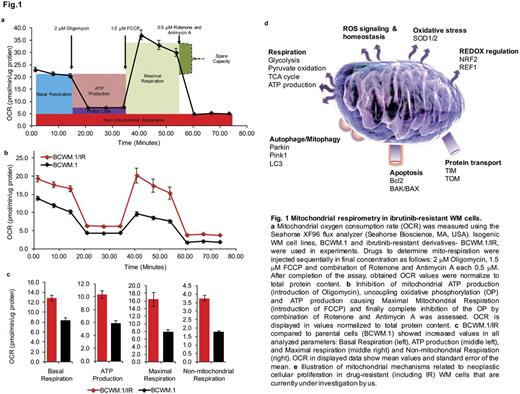Abstract
Background: Mitochondrial activity is critical to maintain a high cellular proliferation especially in drug-resistant clones. Ibrutinib-resistance (IR) in CLL is associated with highly aggressive clinical behavior, carrying a median survival of ~3 months. While these outcomes are not yet reported in WM, resistance to ibrutinib is foreseeable considering no WM patients achieve a complete remission with BTK inhibitors (reported series). The transition to a highly proliferative drive in the IR clone remains a biological dilemma and understanding this will allow rationale development of therapeutic strategies. It is established that increased cell proliferation is highly dependent on the functional capabilities of the mitochondria. Yet the respiratory proficiencies and adaptation of mitochondrial machinery in the IR state remains unknown. Here we interrogated mitochondrial function and its relevance in IR cells using our WM models.
Materials: WM cell lines (BCWM.1, non-IR) and its isogenic IR clone (BCWM.1/IR; 20-fold resistant, without BTK or CXCR4WHIM-like mutations) were used. Mitochondrial respirometry was measured by Seahorse XF96 flux analyzer (Fig. 1a). Drug sensitivity and cytotoxicity were determined by Cell-Titer Glo cell viability assay. Whole exome sequencing (WES) was performed on an Illumina HiSeq2000.
Results: IR WM cells were noted to be in G1 arrest with altered morphologic features and growth kinetics. Despite growth arrest, IR cells showed increased basal oxygen consumption rate (OCR) (>30% increase) vs. parental (non-IR) cells. Consistent with this we observed enhanced mitochondrial ATP production suggesting increased mitochondrial utilization by the IR clones. We then measured maximal respiratory potential of WM cells with FCCP pre-treatment, which evaluates cellular potential to respond to increased ATP demand. We observed upregulation of mitochondrial spare respiratory capacity in BCWM.1/IR cells vs. parental BCWM.1 cell. In addition, a >50% increase in non-mitochondrial oxygen consumption/respiration was also noted (Fig.1b, c). To identify potential genomic changes that could explain mitochondrial overdrive, WES of the non-IR and IR cells was performed. Interestingly, this analysis did not uncover any mutational alterations in genes directing cellular oxidative phosphorylation (NDUF, COX1, COQ7, SURF1, etc.), glycolysis (PDK1, HK2, PKM2, ALDOA, etc.) or ATP production (ATP5, ND1, UCP1 and others). We then asked if mitochondrial function impacts therapeutic potential of a specific drug (or a class of drug), focusing specifically on proteasome disruption. First, we observed that proteasome inhibition- independent of the site (20S vs. 19S), retained high cytotoxic potential, wherein IR cells showed exquisite sensitivity to proteasome disruption. Interestingly, VLX1570 (targets 19S proteasome) had a 2-fold lower IC50 in IR clones than its non-IR counterpart. Cell respirometry demonstrated that compared to parental cells, VLX1570 (500nM) treatment significantly (p<0.002) and rapidly (2hr) attenuated basal respiration in IR clones at concentrations half of those needed to achieve similar effects in BCWM.1 cells. A concomitant decrease in ATP production as well as spare respiratory capacity was observed at these time points/drug concentrations (significantly more evident than in BCWM.1 cells). While our focus was mitochondrial bioenergetics and its therapeutic relevance in drug-resistant WM, unexpectedly we observed for the first time, evidence that VLX1570 induces changes in mitochondrial bioenergetics as early as 2hrs leading to increased mitochondrial membrane permeability and cell apoptosis in 6-12hrs. Comparable observations were made with bortezomib (targeting 20S).
Conclusions: This is the first report identifying the role of mitochondrial hyper-drive in WM cells with resistance to ibrutinib. Of note, enhancedmitochondrial bioenergetics in the IR state increased sensitivity to proteasome inhibition and this was independent of the site of disruption in the proteasome pathway. Although, WES findings alone were not sufficient in explaining mitochondrial overdrive noted in our system, ongoing analysis of various mitochondrial functions (Fig. 1d) at the gene expression, copy number and epigenetic level may elucidate the underlying biomechanics of mitochondrial disposition in IR WM cells.
Ansell:BMS, Seattle Genetics, Merck, Celldex and Affimed: Research Funding. Linder:Vivolux, Ab: Other: Shareholder. Ailawadhi:Pharmacyclics: Consultancy; Novartis: Consultancy; Amgen Inc: Consultancy; Takeda Oncology: Consultancy.
Author notes
Asterisk with author names denotes non-ASH members.


This feature is available to Subscribers Only
Sign In or Create an Account Close Modal